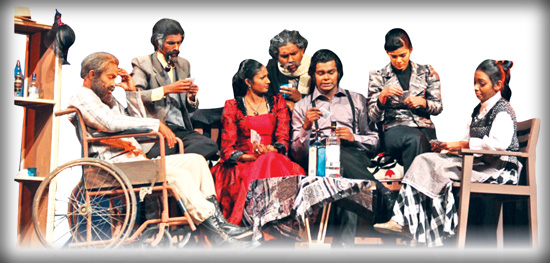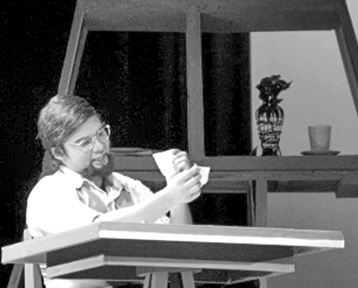|
Drama review
Muhudu Lihiniya: Sieving art out of life
By Dilshan Boange
“Being a small time writer is also a glory of some sorts, isn’t it?”
is the effect to which the words spoken by the character of Piotr Sorin
in the Sinhala translation of Anton Chekov’s The Seagull.
I smiled to myself seated in the gentle darkness in the Tower Hall on
December 17 as I listened and grasped those words, watching Muhudu
Lihiniya (The Seagull) produced by the Tower Hall Theatre Foundation
which marked the directorial debut of Sampath Perera who must be
applauded for his proven capacity to mould a superb performance by a
troupe of young amateur actors whose natural talents for acting and
commitment to the art of theatre were strikingly visible.
|

Director Sampath Perera |
They brought to life on the boards of the Tower Hall a play of the
Russian master dramatist Anton Chekhov.
The credit of the Sinhala translation goes to Ariyarathne Vithana.
The text is one that held the solid foundation of a work that
represented the Russian cultural ethos through a Sinhala lingual
depiction that was very much addressed to the mainstream theatregoer and
not bombastically peppered with high flown literary Sinhala.
The play unfolded captivatingly as a performance and was convincing
as a story from another culture that was channelled to a Sri Lankan
audience through the use of solid purposeful translation which did not
incorporate or contrive goals of an ‘adaptation’.
At times I have seen how a work of theatre labelled a ‘translation’
of a foreign play is moulded with a very significant local twist in
terms of not only linguistic aspects but also the setting and cultural
significations.
Purpose of life
At the very heart of the play are several questions on the purpose of
life as investigated through art. What is the purpose of art? And how
does it come into being? If the former is answered, the latter will
likely be demystified. That is possibly one of the revelations that
pulsates in the play.
As the Czech writer Milan Kundera explains in his literary
discourses, one of the central purposes of fiction as an art in Western
Europe was to try to find answers to various questions about life within
the work of fiction itself. The world created through the narrative is
thereby meant to be a world by itself. Like a number of the great
thinkers of the West who turned to art for answers to existential
questions and created an investigative premise of the human psyche in
their artistic creations, Chekov too in The Seagull presents the viewer
with a glimpse of the proposition that art may reveal the answer.
The play gives a glimpse of what dogged the psyche of the Russian
provincial upper class and the intellectual elite of the times. Their
questions related to the tortured soul within the human being.
In this regard Western European culture treated the arts and letters
as vital to sustain the spiritual being of man.
The play shows characters such as the ageing actress Irina Arkadina
yearning for continued appeal both socially and sexually, resent
provincial life as boring and deadening her vivacity.
Her elder brother Sorin, tormented by ill health and with two failed
ambitions in life - to get married and be a writer - yearns to visit the
city and have an excursion to escape the humdrum country side.
There is a strong desire in them to escape the dreariness of
provincial life and seek the excitements of urban living.
To the aspiring young actress Nina Zarechnaya going to Moscow to
pursue her dreams of being a stage actress results in what is her moral
deterioration, although the ‘veneer of urbaneness’ has been successfully
daubed on her facade.
The result of renouncing provincial life, thus, depending on the
character, has many significations. On the theme of what art means to
Russian society of the time, the play shows an interesting aspect of how
two specific forms of expression - writing and theatre are discussed
within the context of artistic aspirations. Boris Trigorin, Irina’s
lover is a celebrated writer, Sorin dreamt of being one while Kostia
Treplev, Irina’s disaffected son who is deeply tormented by his station
in life and his mother’s lifestyle, develops into a writer towards the
end of the play. Irina is a highly acclaimed theatre actress while Nina
pursues her dreams of being an actress.
There is that unmistakable statement in The Seagull, that art is
always something larger than life. Part of escaping the provincialism
that some of the central characters are affected by is to do with how
they see art as a means of transforming the mundane person to something
larger than life.
It is this notion that drives them to pursue their ambitions of being
recognised for artistic accomplishment.
Commitment
Chekov shows us that the writers and actors endeavour to achieve an
‘image preservation’ of themselves in the minds and eyes of those who
perceive their work. The commitment to the arts is thus contended as
perhaps for the very objective of defeating our mortality.
 Thereby Chekov offers a glimpse at the spiritual aspiration within
man to unravel the answer to an existential question. Why do we pursue
artistic goals? The happiness art brings us is the result of our
disaffection, the dissatisfaction we have with our reality. Art, is thus
a form of escape. Thereby Chekov offers a glimpse at the spiritual aspiration within
man to unravel the answer to an existential question. Why do we pursue
artistic goals? The happiness art brings us is the result of our
disaffection, the dissatisfaction we have with our reality. Art, is thus
a form of escape.
The underlying investigation of what art is, lends to a much more
specific critique and contention in the text of the play, which is, what
is theatre? The ‘play’ that Kostia presents with his ladylove Nina in
performance on the boards of a rudimentary makeshift theatre structure
put up in their estate ends unsuccessfully due to audience response
being not to Kostia’s expectations. “Natya kalavata aluth aakruthiyak
one.” (The art of theatre needs a new structure) says Kostia to his
uncle Sorin in the dialogue of the first scene itself.
It got me thinking of how the Sinhala play Suddek Oba Amathai by
Udayasiri Wickremaratne was very much a deviation from the structures of
drama as generally perceived.
Wickremaratne’s play has even been contested by critics as not
qualifying as a stage drama. Yet it has received some considerable
public demand over the course of time. And interestingly,
Wickremaratne’s most recent creation to the stage – Rangapem ivarai
(Adieu to Acting) is very much a work of a similar ‘structure’ as his
previous play.
Desire
What is theatre is a stinging question affecting Kostia who devises
means of expression that fulfil his desire to artistically voice his
unspoken feelings. What unfolds as the ‘drama’ or ‘play’ with Nina as
the ‘artiste’ is a solo act. If that performance is extracted as a
separate ‘work’ and juxtaposed with the play ‘The Seagull’ or any other
play of Chekov for that matter such comparison would show they are
‘works’ which are worlds apart in form and content.
What one finds in the language of that solo act delivered by Nina
scripted and directed by Kostia is a dramatised monologue built on
imagery bound with metaphoric language rendering it a highly poetic
expression. It is more a poem in performance than a plot in action.
In this day and age one could liken it to a performance of ‘Slam
Poetry’. Today’s theatre could accept it as a solo act play. But alas to
Kostia’s audience it failed to form a valid ‘structure’ and conform to
the definition of ‘theatre’. Perhaps Chekov was indicating what people
during his time validated and accepted and rejected as ‘theatre’.
This play is thus important to glimpse how Russian society at the
time grasped and engaged with theatre. The Seagull can be looked at for
its merits as a social critique of art criticism in Russian society at
that time.
Focusing on aspects of the production I would say the director had
devised what was practically achievable giving thought to set design and
logistics since one cannot expect a Broadway production and must
appreciate the limits within which the Sri Lankan theatre practitioners
work.
|

A scene from the play |
The stage sets were tastefully done, being more than the minimalist
while of course not being elaborate to the extent that a play of the
realist genre like Chekov’s would ‘ideally’ demand when performed in
grand theatre’s in Moscow.
Recognition
I say this to give recognition to the limits in resources our artists
face in general, especially with regard to theatre, and the need to
appreciate what is devised to drive a convincing setup of what the
setting is meant to be in the eyes of the viewer.
Furniture too after all are very much part and parcel of the
narrative when it comes to theatre.
A detail I could not help but notice with regard to stage props was
that a number of characters drank from a bottle that was to my
discerning a bottle of Bombay Sapphire (A brand of Gin).
The character of Masha said her choice of ‘poison’ is usually Vodka
or Cognac. And I have my doubts whether Gin was actually much known to
people in Tsarist Russia.
However, I will not venture to say that it was a matter of critical
importance to the credibility of the narrative. The bottle, after all,
as a material object devoid of its label served the purpose!
The costume designs and make-up were commendable and convincing. The
stage lighting was generally executed well although a few minor lapses
in timing did occur.
The music was satisfactory, but at times did not contribute in equal
measure to complement the other elements that weave the texture of a
given scene. Music was one aspect I felt could have been improved in
this production.
The strength of any play as a performance rests on the script and the
skills of the actors to bring characters to life though their verbal
tones, physical gestures, facial expressions and the deft blending of
those elements to artfully time and deliver the performance in the
complex ‘interplay’ with fellow actors.
I would unhesitatingly say that the most potent resource that Sampath
Perera possessed to make the show a success was his talented troupe of
actors.
Acting talent
There was an evenly balanced fabric of acting talent that brought the
play to life and these budding actors must be congratulated for their
performance of Muhudu Lihiniya.
Their performance indicated that although they are still amateurs in
the field, their level of commitment has paid off. There was not a
single line fumbled by any one of them as far as I could scrutinise.
Their timing with one another to interplay was well executed. In
short, they were very thorough with their roles and delivered much more
than simply their lines on cue.
The cast of Muhudu Lihiniya comprised Buddhini Peiris, Prabhash
Weerakotuwa, Sumadhu Chathuranga, Samantha Paranaliyanage, Nayomi
Thakshila, Ranga Jayawardhane, Ruwanthi Nimanthika, Prinyanwada
Nilaweera, Chathuranga Ekanayake, Manuja Udawaththa, and Nadeera
Udagedara. Special mention must be made of the two young actresses
Buddhini Peiris who played Irina and Nayomi Thakshila who played Nina
whose performances were notably striking on account of their ability to
project their character’s persona with subtle nuances and mercurial
flexes when the mood of the situation demanded it.
Nayomi Thakshila delivered her role in a manner that displayed her
natural acting abilities. She brought Nina to life, enchantingly. Her
performance was brilliant, her presence was sparkling.
The actor who played the role of the estate manager too must be
commended for his captivating performance, as well as Sumadhu
Chathuranga for his portrayal of the devious and surreptitiously
exploitative Boris Trigorin.
The production showed a host of talents that must be cultivated and
supported to continue to contribute to theatre in our country. Perera
and his team of actors and the rest of the members of the production
must be congratulated for their triumph with Muhudu Lihiniya.
I salute them for an appreciable production, and wish them well for
their future success. |

